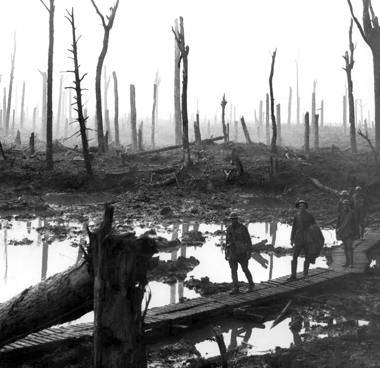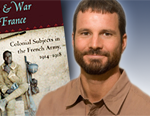UAlbany Expert: Effects of World War I Still Resonate in 2014
 |
|
World War I inaugurated industrialized war and killing, with chemical weapons and other weapons of mass destruction, states UAlbany Associate Professor of History Richard Fogarty.
|
ALBANY, N.Y. (September 23, 2014) -- In 1914, the year World War I began, royal houses still ruled Germany, Russia and many of the most powerful nations of the time. By the conclusion of the war in 1918, more than 16 million would lose their lives, national upheaval would see the overthrow of governments and the execution of the Russian Tsar, and the United States would rise to become one of the great world powers.
Richard Fogarty, University at Albany Associate Professor of History, is an expert on Europe, imperialism, national identity and the impact of World War I. He discusses how the impact of "The Great War" is still felt in the 21st Century.
Q: In what ways has World War I shaped today's world?
A: Some of the most important effects of the war echoed throughout the 20th century and still resonate even today. For instance, many historians regard 1914 as the beginning of "short 20th century," a period lasting until the fall of the Soviet Union in 1991. This is a period that saw extraordinary violence and dizzyingly rapid political, social, economic, and technological change on unprecedented scales.
World War I inaugurated industrialized war and killing, with chemical weapons and other weapons of mass destruction. The war directly brought on the Russian Revolution in 1917, an event that shaped subsequent history in profound ways. Four of the world’s great empires fell—the German, Austro-Hungarian, Russian, and Ottoman Empires—replaced by new nation states.
Millions of people from all over the world converged on battlefields in Europe and elsewhere, including, for example, Americans, Indian subjects of the British Empire, Africans and Asians from the French empire, and many, many others. The United States emerged fully onto the world stage as an active and interventionist world power, animated by a particular vision of the global economic and political order.
And, to cite an area that people will certainly recognize as critically important here in the 21st century, World War I shaped the modern Middle East, setting in train events that would lead to the creation of Israel, and shape states and politics in places like Syria, Iraq, and the Arabian peninsula. It is no accident that Dexter Filkins’s riveting book of reportage on recent events in Iraq and Afghanistan, The Forever War, ends with him contemplating the headstone of a 21 year-old British soldier killed in Iraq in 1918.
 |
|
UAlbany Associate Professor of History Richard Fogarty
|
Q: What influence did World War I have on the U.S. in particular?
A: Commemoration in Europe, especially, in this centenary year of 2014 is particularly active. That is as it should be, since the war began there. The United States did not enter until 1917, so it is possible that we will see commemorative activity here in three years’ time. But World War I tends to be overlooked, somewhat forgotten in this country. World War II saw longer and more extensive involvement, and its profound and lasting effects on this country can obscure the events of a quarter century before. Yet, although less deadly than World War II, the first war killed well over 100,000 Americans, and wounded more than twice that number. Millions of men registered for the draft for the first time.
The military underwent a massive expansion and professionalization that shapes the military and politics in this country to this day. Some two million Americans served in France, including men like future president Harry S. Truman. African Americans entered the army in large numbers, and African American internal migration from the south to the north accelerated dramatically, transforming the racial landscape of the US. American President Woodrow Wilson’s Fourteen Points provided a lasting, if complicated, vision of a transformed world order that would be deeply influential down to our own day. These are just a few examples, but show that if great transformative events are worth commemorating, events noting the centenary World War I ought to take their place alongside other historical commemorations in our culture.
Q: Why did the U.S. go to war if it was mainly fought in Europe?
A: The story of why the US went to war in 1917 is complex. Wilson had campaigned for reelection in 1916 on the slogan, “Kept us out of war.” Americans since Washington had been leery of involvement in Europe’s endless violent quarrels, and the appalling slaughter of World War I seemed to vindicate the wisdom of this stance. Yet despite official neutrality, the United States’ status as a world political and economic power meant that its interests intersected with those of the warring nations in Europe.
Germans recognized that Americans’ trade with France and Britain, in particular, helped sustain their war efforts. German submarines targeted American shipping, particularly in early 1917. Knowing that this would provoke a reaction, the Germans also tried to persuade Mexico to join Germany in a war against the U.S., hoping to keep the U.S. tied down closer to home until Germany could win in Europe. So German diplomatic and naval action in the end led Wilson to argue that Germany had repeatedly committed “acts of war” against the US. Congress agreed, and voted to declare war. Wilson had also presented American intervention as a moral imperative. Famously, he painted the war as a struggle for liberty and democracy against tyranny and dictatorship, declaring that, “The world must be made safe for democracy.”
Q: What advances (i.e. in science, medicine, technology) can we trace to World War I?
A: It is ironic that such a destructive enterprise as war can lead to technological innovation and advances, but it often does. War is a competitive endeavor, and the prices for of failure are the ultimate ones: defeat and death. World War I was no exception to this trend. As the firstly truly industrialized war, in which technologically sophisticated weapons played a large role, this war helped propel forward modern technologies on and off the battlefield, a process that World War II would accelerate dramatically.
Many of the "advances" of World War I were, as we might imagine, technologies of violence. The tank, military airplanes, flamethrowers, poison gas, submarines, depth charges, new forms of artillery and techniques for using it, more efficient and powerful machine guns all either appeared for the first time during the war, or saw decisive improvements that made them recognizably "modern" in form. Battlefield necessities provoked improvements in telephone and wireless communication, railway travel, and even weather forecasting. Efforts to treat the wounded led to medical advances, both technical and procedural: storing blood for transfusions; the practice and even the term “triage,” French doctors’ term for categorizing and prioritizing treatment; advances in facial reconstructive surgery and artificial limbs.
Psychiatric treatment advanced as well, through the first widespread recognition and treatment of "shell shock," today known as PTSD. Everyday technologies we might not associate with war developed as well. Female nurses used the cellulose cotton of bandages for their monthly period, inventing the modern sanitary napkin. Other technologies we take for granted in today’s world—stainless steel, zippers, tea bags, air traffic control, daylight savings time, the wristwatch, and many others—either appeared for the first time or saw their first widespread use and development. The effects of the First World War on our world are everywhere, in fact.
![]() For more news, subscribe to UAlbany's RSS headline feeds
For more news, subscribe to UAlbany's RSS headline feeds
A comprehensive public research university, the University at Albany-SUNY offers more than 120 undergraduate majors and minors and 125 master's, doctoral and graduate certificate programs. UAlbany is a leader among all New York State colleges and universities in such diverse fields as atmospheric and environmental sciences, business, education, public health,health sciences, criminal justice, emergency preparedness, engineering and applied sciences, informatics, public administration, social welfare and sociology, taught by an extensive roster of faculty experts. It also offers expanded academic and research opportunities for students through an affiliation with Albany Law School. With a curriculum enhanced by 600 study-abroad opportunities, UAlbany launches great careers.


